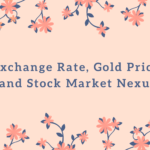Indians are known for a variety of things around the world, including their hospitality, food, vibrant lifestyle, Bollywood, dancing, and so on. Many people are unaware that Indians have a fondness for the gleaming things in life, particularly gold. Indians are the world’s top gold consumers, with approximately 2,000 tonnes of unused gold in the country, making it a veritable gold treasure trove. Gold price today has been increasing for generations, surviving the test of time and growing stronger with each passing day.
Gold is considered auspicious by Indians, and it has become an important component of their culture. Gold adds spark and glitter to our festivities, making them uninteresting without it. In India, buying gold is a long-standing habit that persists regardless of gold prices. We, as a country, are more than willing to pay the gold price today, but have you ever thought about what elements influence gold price today? Things are commonly regarded at face value, and gold is no exception. Today gold price in India fluctuates depending on the market.
How does India Determine Gold Price Today?
The gold price India has been witnessing is determined by the following factors:
Inflation
Gold has a higher value and is used to protect oneself from inflation because, unlike the currency, it has a fairly constant worth. This is why gold is preferred over currency by investors. As a result, when inflation rises, so does the demand for gold, and vice versa. In such a circumstance, the price of gold will rise, causing a surge in customer demand.
Government Gold Reserves
The central banks of several countries retain both currency and gold reserves. The gold price today rises whenever large countries’ central banks begin to hold gold reserves. It occurs because the market’s cash flow has increased while the supply of gold has decreased.
Movement Across the Globe
The price of the metal in India is affected by global movements. This is because India is one of the world’s leading importers of gold, and fluctuations in import prices as a result of global events are reflected in the price of gold in the home nation. Because the value of money and other financial instruments may fall during a political upheaval, investors typically look to gold as a haven. Furthermore, demand and price of gold rise during political upheavals compared to quiet times.
Rates of Interest
The demand for gold is closely tied to interest rates on financial products and services. Today gold prices are regarded as trustworthy indications of a country’s interest rate trends. Customers sell gold in exchange for cash when interest rates are higher, and a bigger supply of gold results in lower gold rates. Lower interest rates, on the other hand, translate into more cash in the hands of customers, resulting in increased demand for gold and, as a result, an increase in the metal’s price.
Market for Jewellery
In India, buying gold jewellery for festivals and weddings is a frequent occurrence. As a result, during the wedding season and celebrations such as Diwali, the price of gold rises due to increased consumer demand. Gold is in high demand for many reasons other than just jewellery. As a result, local demand for gold has risen to the point where India has to import large quantities of metal regularly. The demand for gold in the industrial sector accounts for 12% of the total demand in the country.
For those with an inquisitive mind, here are some “behind the scenes” variables that influence the gold price today in India.
Supply
Gold has become a rare commodity in its natural form, with only a few nations possessing large quantities. As a result, the supply of new gold is not constant, fluctuating from time to time, forcing us to make do with the present market supply. When the demand and supply equation changes, prices can alter dramatically, and this is always a consideration to consider when calculating rates in India.
Import Rates
India’s natural gold reserves are declining, and the country’s gold production is falling compared to previous years. As a result, the majority of gold used in India is imported, making import duties a significant determinant of gold pricing in the country. A high import rate will inevitably lead to higher rates and vice versa.
US Dollar
Gold rates are highly influenced by the performance of the US dollar, with prices inversely proportional to dollar rates. Because gold is an internationally traded commodity and the US dollar favours international currency, this link exists. Any changes in the United States will inevitably impact gold price today, either directly or indirectly. Because the vast majority of gold purchased in India is imported, prices in India are influenced by global markets.
International Relations
Tensions between global powers can push up today’s gold prices, influencing international relations between nations. For example, if the United States has strained ties with a major gold producer, gold prices may suffer as a result of a supply shortage. Gold rates are influenced by the ease of sanctions and broader global relations, primarily because gold is viewed as a hedge against political instabilities.
In addition to the elements described above, several more factors influence the price of gold, such as gold production and its cost. But it’s important to remember that, no matter how many factors influence gold prices, it ultimately comes down to the demand-supply factor in the end.
What Affects Gold Rates?
Gold valuation is more difficult than asset valuation. The four categories of businesses that make up the industry deal with gold. Exploration and development, mining, consumers, and recyclers are the different types of businesses. Industrial consumers, jewellers, and investors are the three types of consumers.
Today gold prices are fixed on a daily basis. It is an agreement between market participants on the same side to purchase and sell gold at a predetermined price or to maintain market conditions to keep the price stable by managing supply and demand. The London Bullion Market Association is in charge of gold fixing. The prices are established in US dollars every day at 10:30 a.m. GMT and 3 p.m. GMT.
Six fundamental drivers influence gold price today. The following are the details:
- Movements in the prices of other goods, as well as demand these items. The cost of production is priced indirectly.
- Inflation in the United States and worldwide is being driven by an increase in the money supply.
- The Central Bank’s activities include money printing, gold acquisitions, and sales.
- Trade and growth imbalances against the United States have resulted in twin deficits. This results in a fear factor.
- Inflation and wages in the United States are contrasted to real interest rates. This is followed by financial repression.
- In the form of demand and supply, using the production, demand, or inventory formula.
The demand for gold, one of the world’s most valuable commodities, is influenced by the number of gold reserves held by central banks, the value of the US dollar, and the desire to hold gold as a hedge against inflation and currency depreciation.
What are the Types of Prices that Determine Gold Rates?
Spot and futures prices are the two sorts of prices.
- Spot Price – The current market price at which Gold was purchased and sold for Instant payment and delivery is known as the Spot price.
- Futures Price – The price at which futures contract parties agree to deal on the settlement day is known as Futures price.
What are the Sources of Spot Price and Futures Price?
The spot prices were obtained from:
Bullion Merchants and Major Banks
Bullion traders and banks deal in enormous quantities of gold on behalf of their customers. As part of the trading process, they purchase and sell according to gold prices today, providing a trustworthy source of gold spot prices.
OTC (over-the-counter) Markets
This is a non-exchange decentralized market for securities. Instead of trading on a real trading floor, market participants trade through phone or fax. The financial organizations that operate as market makers and propose or ask for a bid are the ones who set the spot price.
What has Made Gold so Expensive Throughout History?
Some argue that gold is a barbaric relic with no monetary value and that it has no intrinsic value. They say that paper currency is the preferred form of payment in today’s economy and that gold’s only worth is as a jewellery commodity. Those who claim that gold is an asset with various intrinsic features that make it special and necessary for investors to preserve in their portfolios are on the other end of the spectrum. They believe that there are as many reasons to invest in gold as there are investment vehicles.
Gold can elicit a subjectively personal feeling, yet it can also become objectified when employed as a medium of exchange. Gold encapsulates the qualitative and ethereal while being quantitative and tangible. Perhaps gold’s distinct brilliance comes from within due to its physical property of absorbing light.
What is Gold’s Closing Price?
Gold doesn’t have a set closing price. As a daily closing price, the firms employ the following two options:
- Closing price computed by the data vendor. The closing of gold price today is determined by data providers using an established methodology.
- Fix gold price
In India, Who Decides on Gold Prices?
Because there is no such thing as a “kingmaker” in the Indian gold sector, today gold prices are mostly established through an informal process. Gold rates in India are influenced by international prices, albeit they may not be identical to those in other countries. The Indian Bullion Jewellers Association, or IBJA, is a crucial player in deciding gold rates in India daily. IBJA members include the country’s largest gold dealers, who have a collective say in setting pricing. These individuals represent nearly all of the legal gold sold and purchased in India, and they hail from all corners of this vast country. In India, gold is mostly imported by banks, which then sell it to bullion dealers around the country. Banks provide this gold to dealers after deducting their fee, which makes them slightly more expensive than the rate at which gold was imported.
The IBJA then begins the process of setting pricing by speaking with the country’s ten largest gold dealers. Depending on the rate at which they purchased gold, these dealers give their respective “buy” and “sell” quotes. IBJA then takes the average of these ‘buy’ and ‘sell’ quotes and uses them to calculate the gold rate for a given day. This average rate has been adjusted for local taxes, and a rate has been set as a result.
Dealers calculate their ‘buy’ and ‘sell’ rates by multiplying/adjusting the international cost of gold by the exchange rate of the Rupee and adding any import tariffs and taxes, such as VAT. Dealers make careful to include their margin in the rates they offer, taking into account their needs. This system assures that gold rates in India are in line with international trends, and buyers may buy gold without fear of being taken advantage of.
Conclusion
Gold has captivated us for a long time and will certainly continue to do so in the future. Demand for gold, the amount of gold in central bank reserves, the value of the US dollar, and the desire to store gold as a hedge against inflation and currency devaluation are all factors that influence the gold price today in India.
Read More: Gold Vs Bitcoin Where Should I Invest My Money In 2021
Frequently Asked Questions (FAQs)
In India, how are gold prices determined?
The basic demand and supply formula determines the price of the yellow metal. Gold (in its natural state) has become a highly rare commodity. There aren’t many countries with large gold reserves. As a result, gold prices are influenced by the demand and supply factors in India.
What is the difference in pricing between 24k and 22k gold?
24-karat gold is 100 percent pure gold, meaning it contains no other metals. 22-karat gold contains 91.67 percent pure gold and is made up of alloyed metals such as silver and copper. This type of gold is primarily utilized in jewellery.
Why does the price of gold differ in India's cities?
Local taxes, gold associations, the quantity of gold acquired, and shipping costs are all elements that go into determining gold rates.
So, what do the MCX Gold rates mean?
The Multi Commodity Exchange of India Ltd. (MCX) is a Mumbai-based independent commodity exchange that was founded in 2003.
Who is in charge of the gold price?
The Indian Bullion Jewelers Association, or IBJA, is a crucial player in deciding gold rates in India daily. IBJA members include the country’s largest gold dealers, who have a collective say in setting pricing.
Also See, Today Gold Rate of Metro Cities in India
What factors influence the gold price today?
Supply and demand dictate the price of this valuable commodity, and the market price for gold is set each day using a deceptively simple procedure. Everyone in the gold sector, from miners to bankers to pawn shops, relies on the official market price of gold.

























